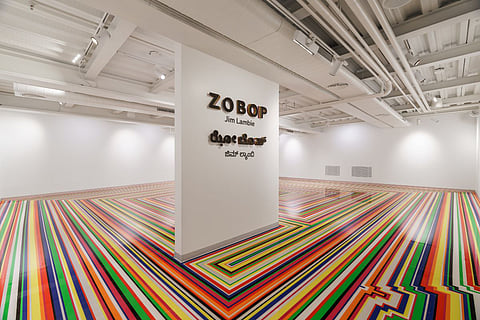Colour Bar Crazy: Here’s why Scottish artist Jim Lambie’s 'Zobop' is the coolest exhibition in Bengaluru right now
Vibrant. Psychedelic. Philosophical. After spending a painful amount of time on coming up with an introduction for this article on Zobop — Scottish artist Jim Lambie’s renowned floor installation that’s recently been put on view at the Museum of Art and Photography (MAP), Bengaluru — these were the three words we wanted to use to describe the feeling the exhibit left us with.
First unveiled in 1999 at Transmission in Glasgow, Jim created Zobop by applying concentric lines of poly-chromatic vinyl strips on the floor. What makes it unique is the fact that the colours and sequence of these lines are different at every display and takes the shape of the gallery where it’s exhibited — making each iteration of Zobop different from its previous versions. We couldn’t help but wonder — when was the last time we had experienced something as structured as straight lines make a work of art so fluid by nature?
The vinyl tapes in the version at MAP comprised pop colours such as green, orange, red and yellow and its concentric lines gave rise to a happy, hippy, psychedelia. “Art is not what you see, but what you make others see,” said French impressionist painter Edgar Degas and what Zobop creator Jim Lambie wanted others to see through this piece intrigued us. Therefore, we set out for a conversation with the artist himself, where he opened up about his inspiration, creative process and more. Excerpts:
Why is the installation titled Zobop?
The artwork was titled Zobop, from a piece of graffiti that I had come across. I liked the word ‘bop' in it. To ‘bop to music' means to dance and I felt that the word had a nice overlap with musical terms such as bebop, which was a form of jazz in the 1940s.
What inspired the creation of Zobop and how did it arrive at this form?
I began by thinking about the architecture of the gallery space. The walls create an edge, an outline or a framework to follow. I start the work by taking one piece of tape and negotiate the outside edge of the room. The colour and width of the tape changes as I work my way towards the centre. It forms a pulse, a beat throughout the room.
How did music influence the making of Zobop?
Music has influenced Zobop from the title and the visual rhythm to the beat and the intense colour. Just like music, the work has an immersive quality, which is often commented on — it’s like a dance floor!
What made you choose pop colours for the installation?
Pop colours were chosen because I wanted a visual overload – I wanted the work to feel as psychedelic as possible.
What influenced your choice of the material for Zobop?
I had been making smaller sculptures held together by sticky tapes. They were lying around my studio at the time, and were inexpensive and simple materials to hand. The initial Zobop was made for my first solo show at an artist-run space in my home town of Glasgow. Conceptually, using the floor area was a way for me to fill the space and empty the space – both at the same time.
Why do you think the installation has appealed to audiences through so many years?
I think viewers enjoy the work for a number of reasons, such as the immersive nature of the work, and of course, the colour. Moreover, due to the site-specific nature of the work, no two works are ever the same. I also believe that the audience appreciate the industry involved to produce such a piece and that the material — sticky tapes — has a common language, which most folks can engage with.
What are your thoughts on Indian art?
I think that the Indian artworks I am more familiar with continue to transcend borders using a visual language that engages at many levels. I'm particularly interested in the performative aspects of Indian art, which can present themselves in such a beautiful way.
Your upcoming projects?
I am currently working on a solo exhibition at Anton Kern Gallery in NYC. This would be followed by a residency in Kyoto, which has been organised through the Oscaar Mouligne Gallery.
Entry free. Till July 21. At the Museum of Art and Photography, Kasturba Road.
Email: prattusa@newindianexpress.com
X: @MallikPrattusa

